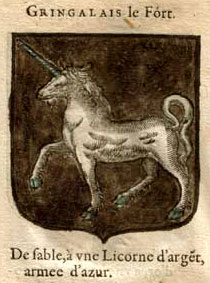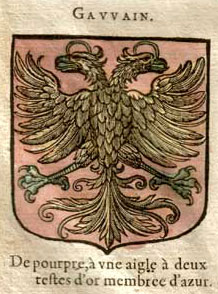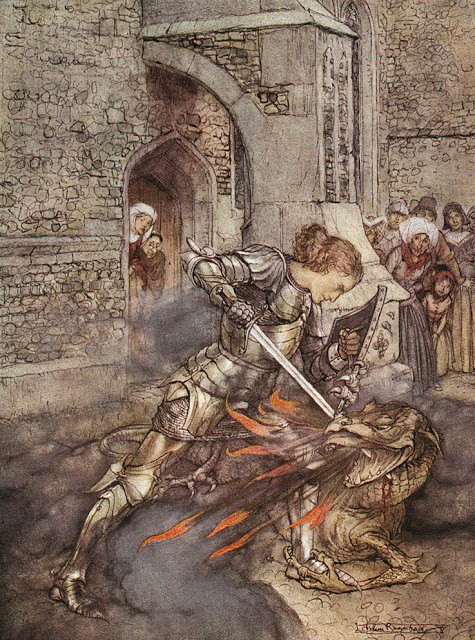|
Gingalain
Sir Gingalain (Guinglain, Gingalin, Gliglois, Wigalois, etc.), also known as Le Bel Inconnu, or The Fair Unknown, is a character from Arthurian legend whose exploits are recorded in numerous versions of a popular medieval romance. His nickname differs depending on the version and language; he is known in English as Libeaus Desconus. He is the title character in ''Le Bel Inconnu'', a poem composed by Renaut de Beaujeu sometime between the mid-1180s and 1230, and in the (destroyed) 13-century manuscript, ''Gliglois''. It is uncertain, however, if the Gliglois of the medieval manuscript refers to Gawain's son or some other character in the "Fair Unknown" cycle. The basic outline of the romance is similar in most sources, with slight variations in emotional emphasis according to the author. Gingalain is the son of Sir Gawain by Blanchemal, a fairy, fay that Gawain meets in the forest. Blanchemal keeps Gingalain's identity a secret from him and never tells him about his lineage. He rea ... [...More Info...] [...Related Items...] OR: [Wikipedia] [Google] [Baidu] |
Gawain
Gawain (), also known in many other forms and spellings, is a character in Arthurian legend, in which he is King Arthur's nephew and a Knight of the Round Table. The prototype of Gawain is mentioned under the name Gwalchmei in the earliest Welsh sources. He has subsequently appeared in many Arthurian stories in Welsh, Latin, French, English, Scottish, Dutch, German, Spanish, and Italian, notably as the protagonist of the famous Middle English poem ''Sir Gawain and the Green Knight''. Other tales featuring Gawain as the central character include '' De Ortu Waluuanii'', ''Diu Crône'', '' Ywain and Gawain'', '' Golagros and Gawane'', '' Sir Gawain and the Carle of Carlisle'', '' L'âtre périlleux'', '' La Mule sans frein'', '' La Vengeance Raguidel'', '' Le Chevalier à l'épée'', '' The Awntyrs off Arthure'', '' The Greene Knight'', and '' The Weddynge of Syr Gawen and Dame Ragnell''. In Arthurian chivalric romance literature, Gawain is usually depicted as King Arthur's clo ... [...More Info...] [...Related Items...] OR: [Wikipedia] [Google] [Baidu] |
Arthurian Characters
The Arthurian legend features many characters, including the Knights of the Round Table and members of King Arthur's family. Their names often differ from version to version and from language to language. The following is a list of characters with descriptions. : Indicates a Knight of the Round Table. See also * List of characters named Ywain in Arthurian legend The following is a list of characters are named Yvain (or a variation of Yvain), mentioned in Arthurian legend. The work(s)in which they appear are italicized.Brugger, Ernst. ''Yvain and His Lion''. Modern Philology. 1941 *Yvain li filz au roi Ur ... References {{Arthurian Legend Arthurian, Arthurian characters ... [...More Info...] [...Related Items...] OR: [Wikipedia] [Google] [Baidu] |
Libeaus Desconus
''Libeaus Desconus'' is a 14th-century Middle English version of the popular " Fair Unknown" story. Its author is thought to be Thomas Chestre. The story matter displays strong parallels to that of Renaut de Beaujeu's ''Le Bel Inconnu''; both versions describe the adventures of Gingalain, the son of King Arthur's knight Gawain and a fay who raises him ignorant of his parentage and his name. As a young man, he visits Arthur's court to be knighted, and receives his nickname; in this case Sir Libeaus Desconus, before setting forth on a series of adventures which consolidate his new position in society. He eventually discovers who is his father, and marries a powerful lady. Other versions of the story include the Middle High German romance ''Wigalois'' (1204–1209) by Wirnt von Gravenberc. The "Fair Unknown" story has parallels in the tale of La Cote Male Taile, Chrétien de Troyes' '' Conte du Graal'', Sir Thomas Malory's ''Tale of Sir Gareth'' from ''Le Morte d'Arthur'', and the ... [...More Info...] [...Related Items...] OR: [Wikipedia] [Google] [Baidu] |
Le Morte D'Arthur
' (originally written as '; inaccurate Middle French for "The Death of Arthur") is a 15th-century Middle English prose reworking by Sir Thomas Malory of tales about the legendary King Arthur, Guinevere, Lancelot, Merlin and the Knights of the Round Table, along with their respective folklore. In order to tell a "complete" story of Arthur from his conception to his death, Malory compiled, rearranged, interpreted and modified material from various French and English sources. Today, this is one of the best-known works of Arthurian literature. Many authors since the 19th-century revival of the legend have used Malory as their principal source. Apparently written in prison at the end of the medieval English era, ''Le Morte d'Arthur'' was completed by Malory around 1470 and was first published in a printed edition in 1485 by William Caxton. Until the discovery of the Winchester Manuscript in 1934, the 1485 edition was considered the earliest known text of ''Le Morte d'Arthur'' and that ... [...More Info...] [...Related Items...] OR: [Wikipedia] [Google] [Baidu] |
Sir Breunor
''Sir'' is a formal honorific address in English for men, derived from Sire in the High Middle Ages. Both are derived from the old French "Sieur" (Lord), brought to England by the French-speaking Normans, and which now exist in French only as part of "Monsieur", with the equivalent "My Lord" in English. Traditionally, as governed by law and custom, Sir is used for men titled as knights, often as members of orders of chivalry, as well as later applied to baronets and other offices. As the female equivalent for knighthood is damehood, the female equivalent term is typically Dame. The wife of a knight or baronet tends to be addressed as Lady, although a few exceptions and interchanges of these uses exist. Additionally, since the late modern period, Sir has been used as a respectful way to address a man of superior social status or military rank. Equivalent terms of address for women are Madam (shortened to Ma'am), in addition to social honorifics such as Mrs, Ms or Miss. ... [...More Info...] [...Related Items...] OR: [Wikipedia] [Google] [Baidu] |
Percival
Percival (, also spelled Perceval, Parzival), alternatively called Peredur (), was one of King Arthur's legendary Knights of the Round Table. First mentioned by the French author Chrétien de Troyes in the tale ''Perceval, the Story of the Grail'', he is best known for being the original hero in the quest for the Grail, before being replaced in later English and French literature by Galahad. Etymology and origin The earliest reference to Perceval is in Chrétien de Troyes's first Arthurian romance ''Erec et Enide'', where, as "Percevaus Welsh person, li Galois" (Percevaus of Wales), he appears in a list of Arthur's knights; in another of Chrétien's romances, ''Cligés'', he is a "renowned vassal" who is defeated by the knight Cligés in a tournament. He then becomes the protagonist in Chrétien's final romance, ''Perceval, the Story of the Grail''. In the Welsh romance ''Peredur son of Efrawg'', the figure goes by the name Peredur. The name "Peredur" may derive from Wels ... [...More Info...] [...Related Items...] OR: [Wikipedia] [Google] [Baidu] |
Gareth
Sir Gareth (; Old French: ''Guerehet'', ''Guerrehet'') is a Knight of the Round Table in Arthurian legend. He is the youngest son of King Lot and Queen Morgause, King Arthur's half-sister, thus making him Arthur's nephew, as well as brother to Gawain, Agravain and Gaheris, and either a brother or half-brother of Mordred. Gareth is particularly notable in '' Le Morte d'Arthur'' in which he is also known by his nickname Beaumains. Arthurian legend French literature The earliest role of Gareth, appearing as Guerrehet, is found in the First Continuation of Chrétien de Troyes's ''Perceval ou le Conte du Graal''. As the protagonist of the story's final episode, he slays the giant known as "Little Knight", thus avenging the death of fairy king Brangemuer, son of Guingamuer and the fay Brangepart. Several of his adventures are narrated in the Vulgate Cycle (''Lancelot-Grail''). In the Vulgate ''Merlin'', Gareth and his brothers defect from their father King Lot and take servi ... [...More Info...] [...Related Items...] OR: [Wikipedia] [Google] [Baidu] |
Lancelot
Lancelot du Lac (French for Lancelot of the Lake), also written as Launcelot and other variants (such as early German ''Lanzelet'', early French ''Lanselos'', early Welsh ''Lanslod Lak'', Italian ''Lancillotto'', Spanish ''Lanzarote del Lago'', and Welsh ''Lawnslot y Llyn''), is a character in some versions of Arthurian legend, where he is typically depicted as King Arthur's close companion and one of the greatest Knights of the Round Table. In the French-inspired Arthurian chivalric romance tradition, Lancelot is an orphaned son of King Ban of the lost Kingdom of Benoic, raised in the fairy realm by the Lady of the Lake. A hero of many battles, quests and tournaments, and famed as a nearly unrivalled swordsman and jouster, Lancelot becomes the lord of the castle Joyous Gard and personal champion of Arthur's wife, Queen Guinevere, despite suffering from frequent and sometimes prolonged fits of madness. But when his adulterous affair with Guinevere is discovered, it causes a ci ... [...More Info...] [...Related Items...] OR: [Wikipedia] [Google] [Baidu] |
Guinevere
Guinevere ( ; cy, Gwenhwyfar ; br, Gwenivar, kw, Gwynnever), also often written in Modern English as Guenevere or Guenever, was, according to Arthurian legend, an early-medieval queen of Great Britain and the wife of King Arthur. First mentioned in popular literature in the early 12th century, nearly 700 years after the purported times of Arthur, Guinevere has since been portrayed as everything from a villainous and opportunistic traitor to a fatally flawed but noble and virtuous lady. Many records of the legend also feature the variably recounted story of her abduction and rescue as a major part of the tale. The earliest datable appearance of Guinevere is in Geoffrey of Monmouth's pseudo-historical British chronicle ''Historia Regum Britanniae'', in which she is seduced by Mordred during his ill-fated rebellion against Arthur. In a later medieval Arthurian romance tradition from France, a prominent story arc is the queen's tragic love affair with her husband's chief knight ... [...More Info...] [...Related Items...] OR: [Wikipedia] [Google] [Baidu] |
Agravain
Sir Agravain () is a Knight of the Round Table in Arthurian legend, whose first known appearance is in the works of Chrétien de Troyes. He is the second eldest son of King Lot of Orkney with one of King Arthur's sisters known as Anna or Morgause, thus nephew of King Arthur, and brother to Sir Gawain, Gaheris, and Gareth, as well as half-brother to Mordred. Agravain secretly makes attempts on the life of his hated brother Gaheris since the Vulgate Cycle, participates in the slayings of Lamorak and Palamedes in the Post-Vulgate Cycle, and murders Dinadan in the Prose ''Tristan''. In the French prose cycle tradition included in Thomas Malory's ''Le Morte d'Arthur'', together with Mordred, he then plays a leading role by exposing his aunt Guinevere's affair with Lancelot, which leads to his death at the hands of Lancelot. In the traditional, albeit contested, division of the massive medieval prose ''Lancelot'' portion of the Vulgate Cycle into three or four parts, the last sectio ... [...More Info...] [...Related Items...] OR: [Wikipedia] [Google] [Baidu] |
Mordred
Mordred or Modred (; Welsh: ''Medraut'' or ''Medrawt'') is a figure who is variously portrayed in the legend of King Arthur. The earliest known mention of a possibly historical Medraut is in the Welsh chronicle ''Annales Cambriae'', wherein he and Arthur are ambiguously associated with the Battle of Camlann in a brief entry for the year 537. Medraut's figure seemed to have been regarded positively in the early Welsh tradition and may have been related to that of Arthur's son. As Modredus, Mordred was depicted as Arthur's traitorous nephew and a legitimate son of King Lot in Geoffrey of Monmouth's pseudo-historical work ''Historia Regum Britanniae'' which then served as the basis for the following evolution of the legend from the 12th century. Later variants most often characterised him as Arthur's villainous bastard son, born of an incestuous relationship with his half-sister, the queen of Lothian or Orkney named either Anna, Orcades, or Morgause. The accounts presented in t ... [...More Info...] [...Related Items...] OR: [Wikipedia] [Google] [Baidu] |









